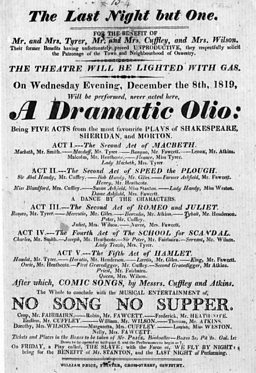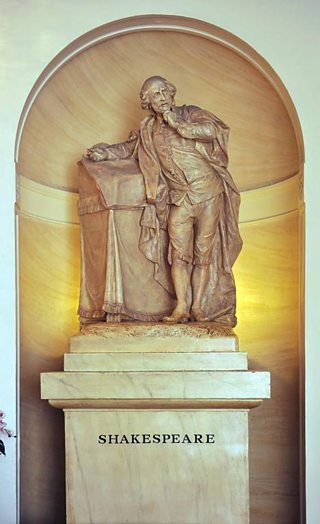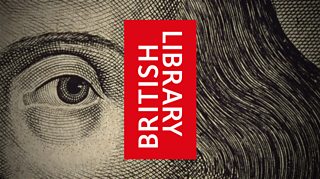Shakespeare… by gaslight!
Romeo and Juliet's 'balcony scene' is already one of the most famous scenes in Shakespeare's works, and we can only wonder what difference the new innovation of gas light in the theatre would have brought to the performance.
This playbill, from Oswestry in Shropshire, is dated December 1819, and invites people to enjoy the newly installed gas lighting in the theatre.
-
![]()
Much ado near me
Hear more Shakespeare stories on BBC Radio Shropshire
-
![]()
Shakespeare Festival 2016
The BBC celebrates the genius of the bard

The first use of gaslight in a British theatre was in 1804, three years before the first public street lighting with gas was demonstrated. The venue was the Royal Lyceum in London, after an entrepreneur called F A Winsor took out a patent on a lighting apparatus based on gas. It was used to light up the facade and entrances to the theatre.
On this night, Shakespeare provides the terror, the passion and the tragedy.
The first theatre to introduce gaslight onto its stage was the Olympic Theatre in Oct 1815 and it impressed the public and the press who described it like the striking of daylight.
In Oswestry, the balcony scene is performed, and is one of five acts from different plays – three from Shakespeare.
These days we would call it a variety show.
This playbill presents a 'dramatic olio', a selection of extracts from well-known plays written by popular dramatists: Shakespeare, Sheridan and Morton.
An olio is an assortment of acts, for example acrobats, magicians and instrumental and vocal soloists.
With its selection of high tragedy and low comedy, the olio offers performers an opportunity to show off their versatility and it is presented by a group of actors – the Tyrers, the Cuffleys and Mrs Wilson.
Sheridan was a playwright and the owner of the Drury Lane Theatre (30 October 1751 – 7 July 1816). The School for Scandal was his best known work, a comedy of class and manners, with characters who are stereotypes.

Speed the Plough is also a comedy, by Thomas Morton, first performed in 1798 at the Theatre Royal, Convent Garden and featuring the unseen but censorious and conventional Mrs Grundy.
So on this night, Shakespeare provides the terror, the passion and the tragedy.
In the second act of Macbeth, the killing of King Duncan is carried out by the malevolent Macbeth inspired by his Machiavellian wife.
In the second act of Romeo and Juliet, the dramatist illuminates the theme of bright youthful love in the famous balcony scene.
In the final act of Hamlet, the Royal family is extinguished. Hamlet avenges his father's death by slaying his uncle, the Queen drinks the poison intended for Hamlet, while he in turn, is killed by a poisoned sword.
About Shakespeare on Tour
From the moment they were written through to the present day, Shakespeare’s plays have continued to enthral and inspire audiences. They’ve been performed in venues big and small – including inns, private houses and emerging provincial theatres.

BBC English Regions is building a digital picture which tracks some of the many iconic moments across the country as we follow the ‘explosion’ in the performance of The Bard’s plays, from his own lifetime to recent times.
Drawing on fascinating new research from Records of Early English Drama (REED), plus the British Library's extensive collection of playbills, as well as expertise from De Montfort University and the Arts and Humanities Research Council, Shakespeare on Tour is a unique timeline of iconic moments of those performances, starting with his own troupe of actors, to highlights from more recent times. Listen out for stories on Shakespeare’s legacy on your BBC Local Radio station from Monday 21 March, 2016.
You never know - you might find evidence of Shakespeare’s footsteps close to home…
Craig Henderson, BBC English Regions
-
![]()
Shakespeare Lives
The nation’s greatest performing arts institutions mark 400 years since the Bard's death
Related Links
Shakespeare on Tour: Around Shropshire
-
![]()
Drunken robbers threaten the leader of Shakespeare's players
As he collects admission money at the door!
-
![]()
A new king and rebranded Shakespeare’s players head first for Shrewsbury
James I established the ‘King’s Men’ as his official group of theatre players
-
![]()
Poverty stricken Bridgnorth ‘splashes the cash’ on Shakespeare’s royal players
Why would a town clearly suffering hard times pay so much?
Shakespeare on Tour: Around the country
-
![]()
A wealthy host attracts Shakespeare's actors to Yorkshire
Shakespeare’s King’s Men visit the Clifford family at Londesborough Hall
-
![]()
Norwich gives Shakespeare's company the cold shoulder
Shakespeare's players paid 40 shillings not to perform
-
![]()
Celebrated young actor stars as Hamlet
Child prodigy actor who took theatres by storm in 1804 stars as Hamlet in Stafford
-
![]()
Much Ado about Dracula?
Much Ado About Nothing at the London Lyceum 1883










